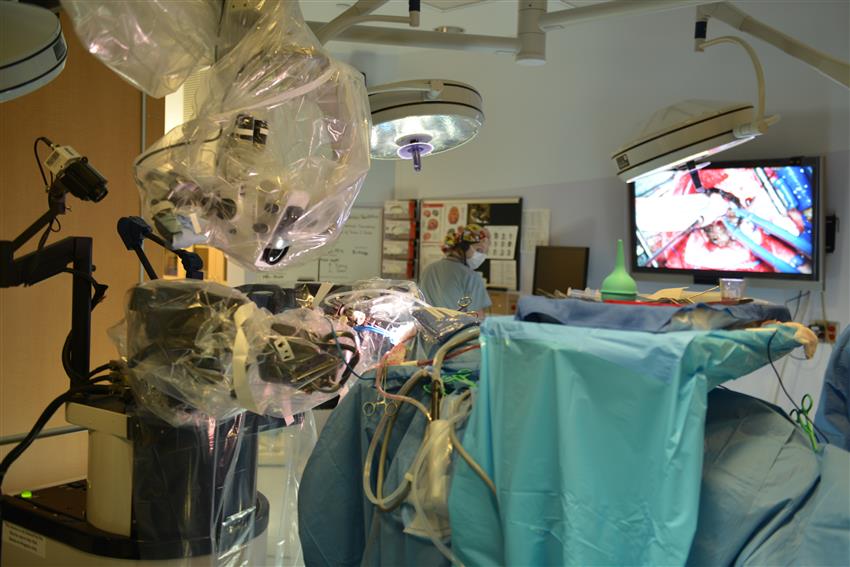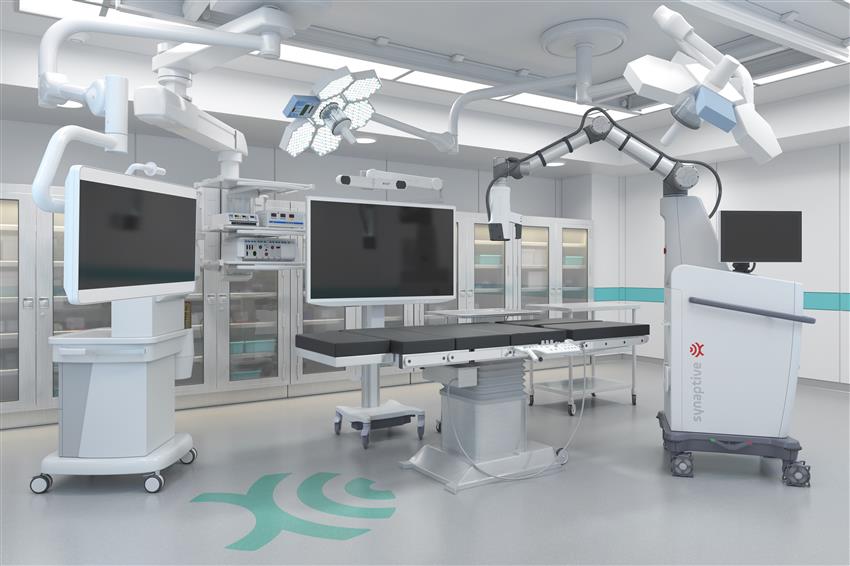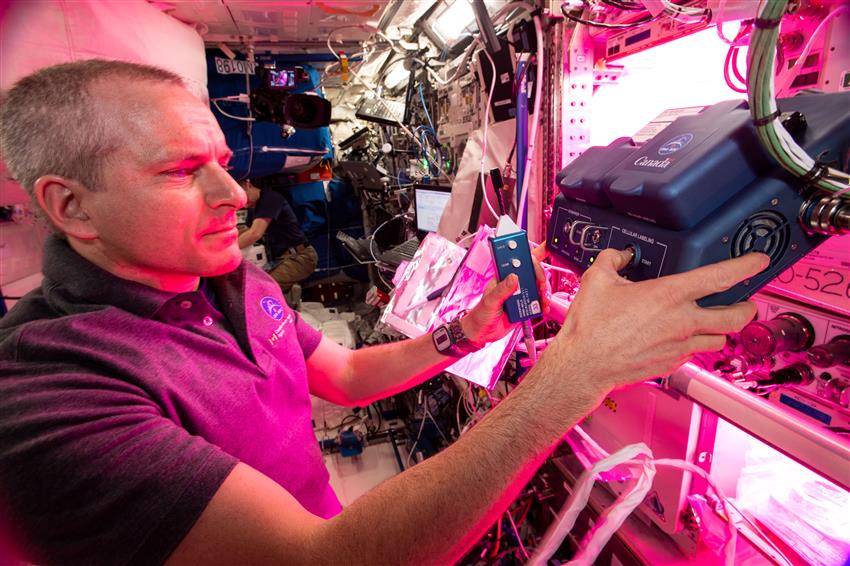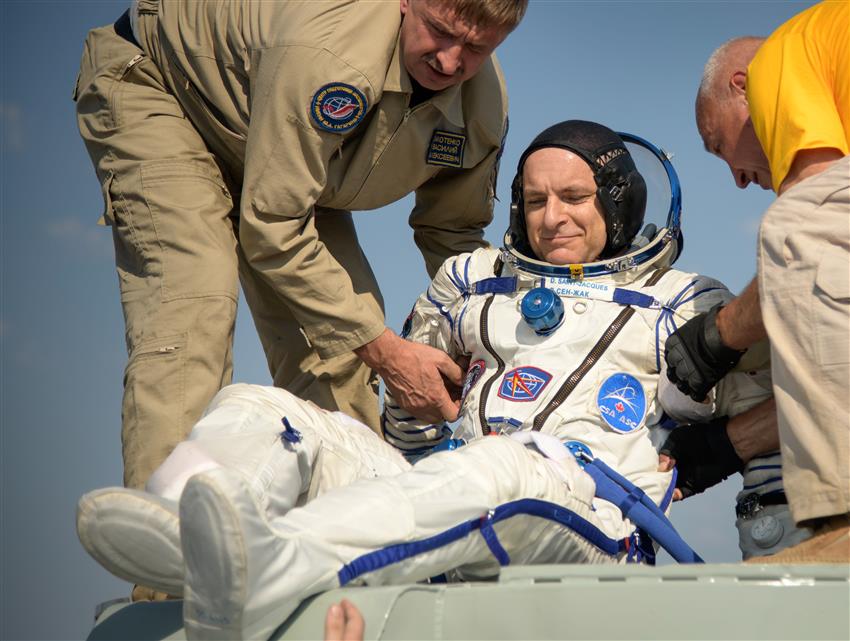Improving health care
Broadening our understanding of the human body
During space travel, astronauts are affected by microgravity, radiation and isolation. Some of the changes in their bodies are similar to health problems associated with aging or a sedentary lifestyle.
Science experiments performed on astronauts in space improve our understanding of medical conditions on Earth. This research has produced findings that can help people suffering from cardiovascular disorders, Type 2 diabetes, osteoporosis and balance problems.
Transforming surgery on Earth
Canadian technology on the International Space Station (ISS) has allowed for innovations in operating rooms. The expertise that powered Canadarm, Canadarm2 and Dextre, Canada's space robots, was used to create surgical robots such as neuroArm, a highly precise robotic arm capable of performing brain surgeries that would otherwise be impossible, and Modus V, a second-generation robotic digital microscope that helps patients with a variety of brain and spine conditions. This technology is allowing neurosurgeons to perform difficult brain surgeries with greater safety and efficiency.
Detecting and treating breast cancer
The technology behind Canadian space robots was used to develop IGAR, a tele-operated medical robot capable of performing very precise biopsies to detect breast cancer. IGAR conducts highly accurate and minimally invasive procedures with less pain and discomfort for the patient.

Credit: Centre for Surgical Invention and Innovation
Providing medical assistance to people in remote areas
Thanks to communication satellites, specialists in urban centres can quickly provide medical advice to health care providers in rural communities.
The Canadian Space Agency (CSA) is collaborating with Canada's space companies and medical community to create more portable medical equipment that can be used when hospitals are not easily accessible, with the goal of improving access to care for people living in remote regions.
Systems developed to track astronauts' health from Earth, like Bio-Monitor and Bio-Analyzer, could be used for patients in remote areas. Bio-Monitor combines numerous devices into one wireless smart shirt and mobile application that measures and records data like heart rate and blood pressure so that scientists can monitor astronauts' health as they orbit the planet. Bio-Analyzer is a new tool that could quickly test samples of blood, urine, or saliva and provide results back to Earth within two to three hours.
These technologies have the potential to improve patient care on Earth through improving access to medical support and reducing wait times for test results.
Volume
Current position:00:00:00
Total time:--:--:--
CSA astronaut David Saint-Jacques explains how the Bio-Monitor, a Canadian smart shirt system, measures and records astronauts' vital signs on the ISS. The sleek, all-in-one garment is used to collect scientific data that is easily sent down to Earth. (Credits: CSA, NASA)
Keeping our hearts healthy
The heart pumps blood through the arteries, providing oxygen to our cells throughout the body. The absence of gravity in space disturbs this process. To shed light on how the human body adapts to weightlessness, the Canadian science experiments in the Vascular series examine space-related changes in astronauts' blood vessels before, during, and after their missions. Studying the responses of the cardiovascular system in space better equips us to understand heart failure and how our arteries age here on Earth.
Thanks to their expertise in modelling fluid flow through rocket engines, space engineers helped design heart pumps. These pumps keep people in need of heart transplants alive by enabling blood to circulate through their body until a donor heart becomes available.

Credit: Blausen Medical Communications Inc., CC BY 3.0
Treating bleeding after childbirth with pressure garments
Spending long periods of time in weightlessness weakens the body's natural adaptations against the effects of gravity, and greatly reduces heart rate and level of physical activity. When returning to Earth, some astronauts wear a g-suit, also called an antigravity suit, to apply pressure to the legs and torso in order to reduce symptoms of cardiovascular deconditioning such as lightheadedness, fatigue, nausea, and fainting. A Canadian study tested several g-suit models to assess their effectiveness in preventing these symptoms in returning astronauts.
Using g-suit technology, non-inflatable pressure garments are being used on Earth to treat women suffering from postpartum hemorrhage by applying external pressure to a woman's entire lower body to stop bleeding after childbirth. This affordable solution is saving lives around the world.




